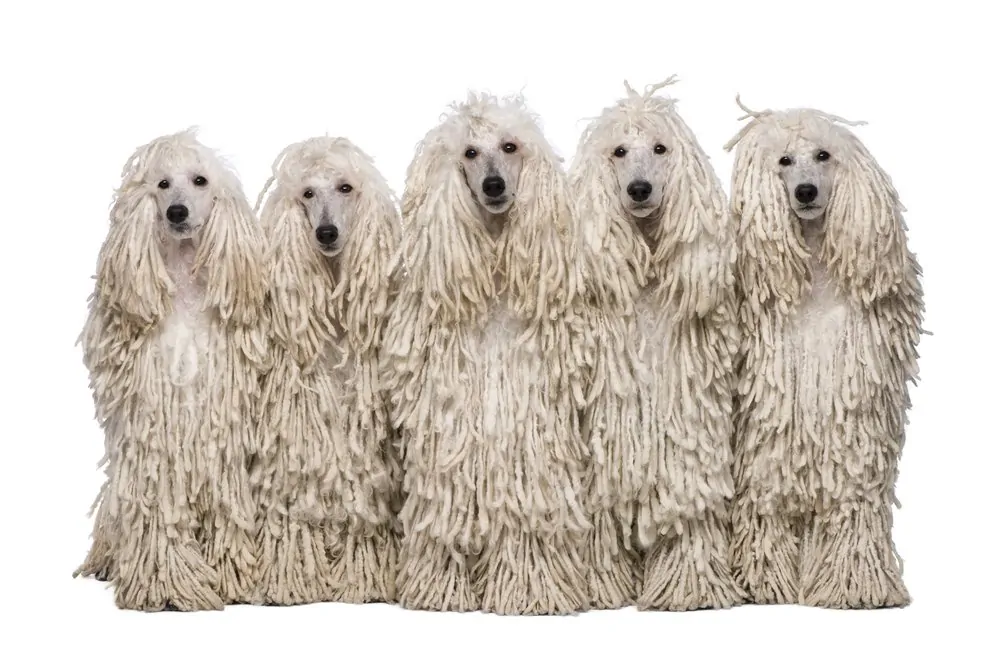Look! It’s a broom! It’s a mop! No—it’s a dog?
For those of us used to soft and plush canine companions, the striking appearance of these mop dogs can be surprising.
As with humans, some of these dreadlock hairstyles are the natural way the fur grows; for others, they must be groomed into the style.
Let’s take a closer look at these dogs that look like a mop and what makes them so unique!
1. Komondor (Hungarian Sheepdog)
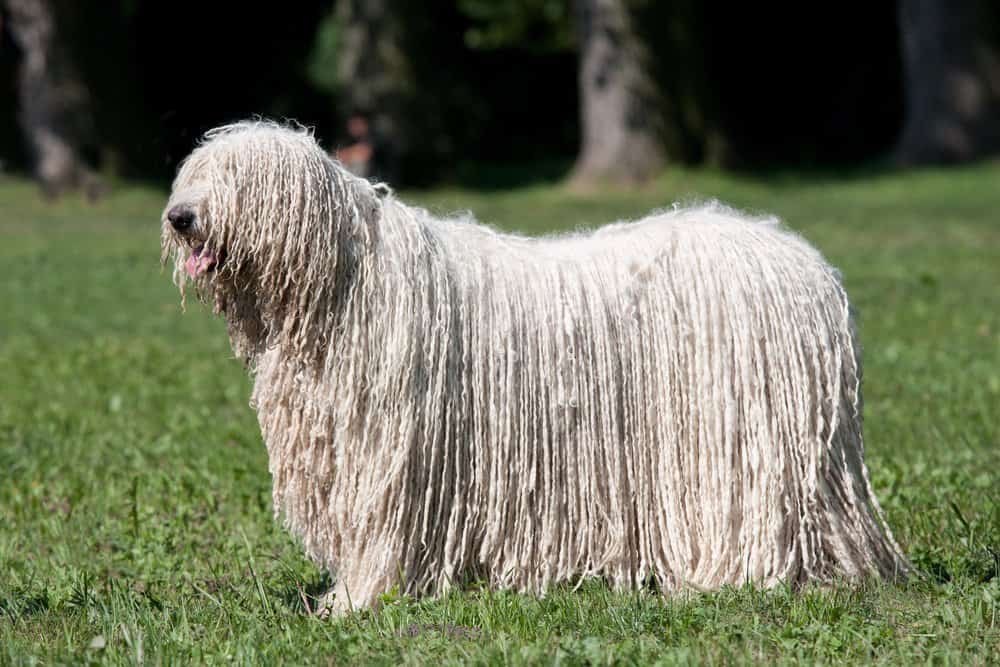
They may look like sheep, and that fits their image—bred as herding dogs, Komondors blend right in with their charges.
This is no coincidence; the Komondor (plural: Komondorok[1]) was bred to go undercover with sheep to surprise any predators who tried to nibble on the flock.
When wolves would try to eat helpless lambs, they’d get a nasty surprise when these guard dogs would turn around and bare the own teeth!
Possibly the most readily recognizable of the corded dog breeds, the Komondor hails from Hungary.
There is some debate as to what brought them there; did they descend from nomadic tribes in Mongolia, or were they brought over with the Huns as they carved a path through Eastern and Central Europe?
However they made it to Hungary, the breed was first mentioned by name in a codex in the 1500s.
Once set, the standards for the breed have revolved around these dreadlocks that give the Komondor its notable mop-like appearance.
According to the American Kennel Club, any member of the breed without the distinctive cords will be immediately disqualified from any competitions.
Since a single Komondor can have hundreds and even thousands of cords, the weight quickly adds up, and some Komondor coats alone weigh more than 10 pounds.
Their breeding as herd protectors makes them excellent guard dogs, but it also can make them antisocial and hostile.
They don’t do well with strangers, whether it’s people or other pets that they don’t know.
Unless they’re living in a remote location and don’t get many visitors, families with Komondors would do well to make sure they’re socialized while they’re still young to avoid trouble with neighbors.
2. Hungarian Puli Dog
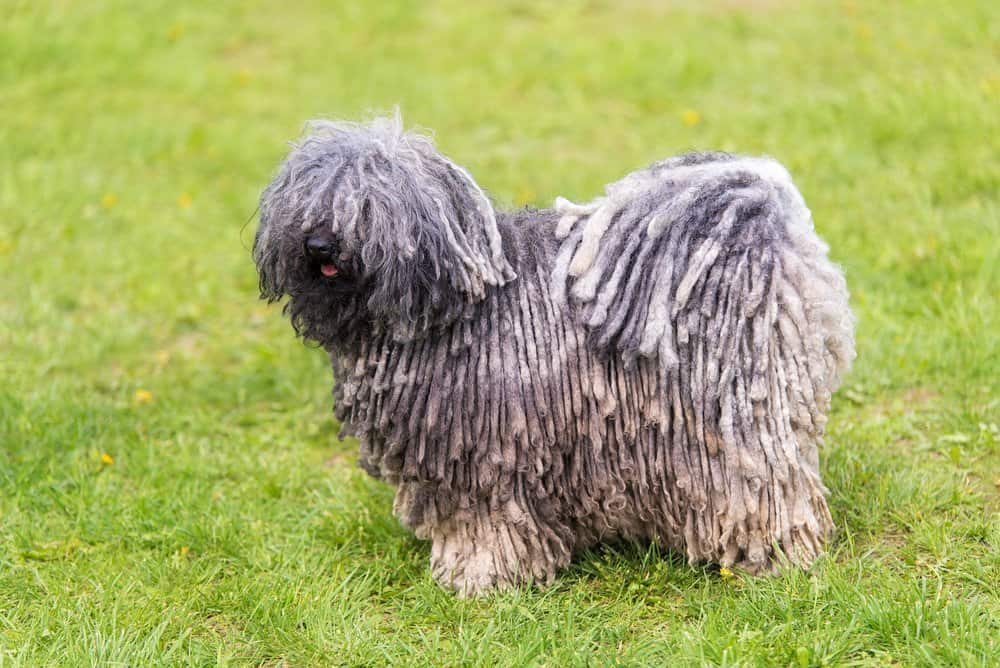
Another breed of Hungarian descent, the Puli also likely has its origins in Central and East Asia.
Related to the Tibetan Terrier, the Puli is thought to have made its way to Hungary as a companion to the nomadic tribes that wandered through what is now Mongolia in the 10th century.
Like the Komondor mentioned above, the distinctive corded coat of the Puli made it a popular choice as a sheepdog, since it guards the herd from predators and thieves by its camouflaged position inside the flock.
Since Pulis come in both light and dark colors, they traded off; lighter Pulis would guard the herd at night, and the darker ones would drive the flock while the sun was out.
The coat of this mop dog covers its body so completely that it can be difficult to tell whether you are looking at its face or its posterior!
World War II did real damage to both Hungary and the dogs that lived there, drastically bringing down the number of Pulis left in the world.
Thankfully, its popularity meant the Puli lived to see another day. Breeders brought surviving dogs out of Hungary and to other countries, especially the United States and Canada, to continue the breeding tradition.
3. Havanese
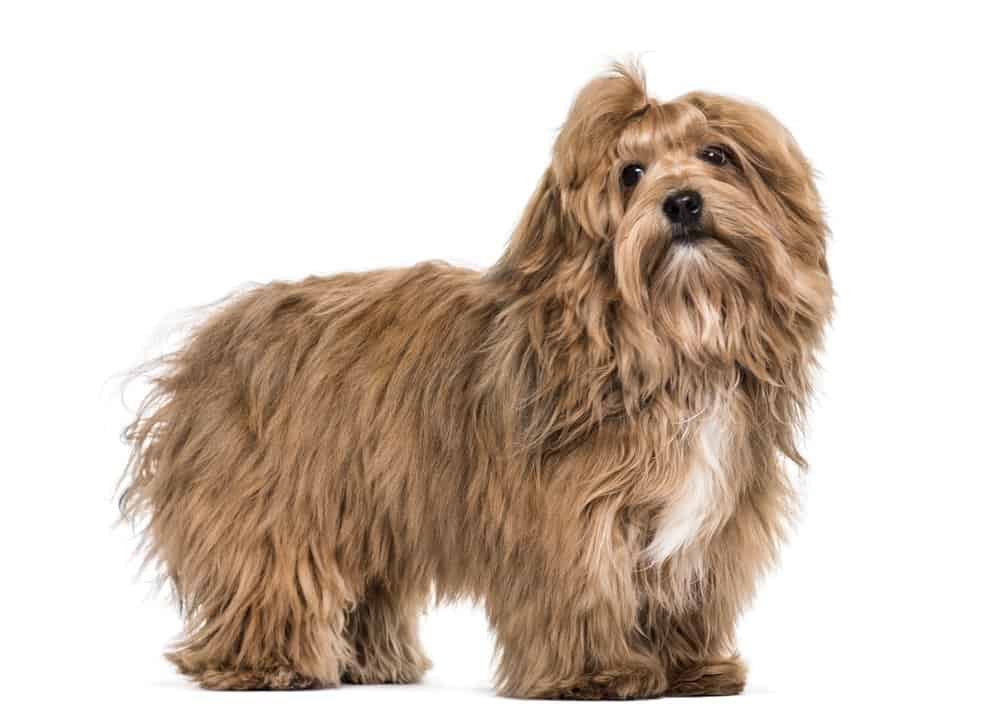
The Havanese proves that size isn’t everything when it comes to mop dogs. Although a more recently-established breed than the more ancient Komondor and Puli, the Havanese can still trace its history back several centuries.
A member of the Bichon family of dogs, the Havanese descended from dogs that came with farmers to Cuba in the 1500s.
When the Havanese moved from the farms of Cuba to the cities—most notably, Havana, from where it gets its name—it turned from a farm dog to an inside lap dog, popular as a family pet.
It would be another couple of centuries before Europeans would “discover” the breed on their trips to the tropical island, but the Havanese became famous once they did.
Cording in a Havanese happens naturally, but it can take a lot of time and commitment to achieve the look without it looking dirty and matted.
The biggest hurdle is the initial work separating the cords from a Havanese’s skin and each other.
If you can run your hand through the dog’s coat without having to detach any cords from each other and without your movement being restricted in any way, you’ve achieved proper cording.
Once you’ve got the cording started, they tend to grow in without much more difficulty.
Smaller than the other dogs on this list, the Havanese is a great choice of dog if you’re looking for the unique mop look but still want a dog that can fit in your lap.
4. Spanish Water Dog
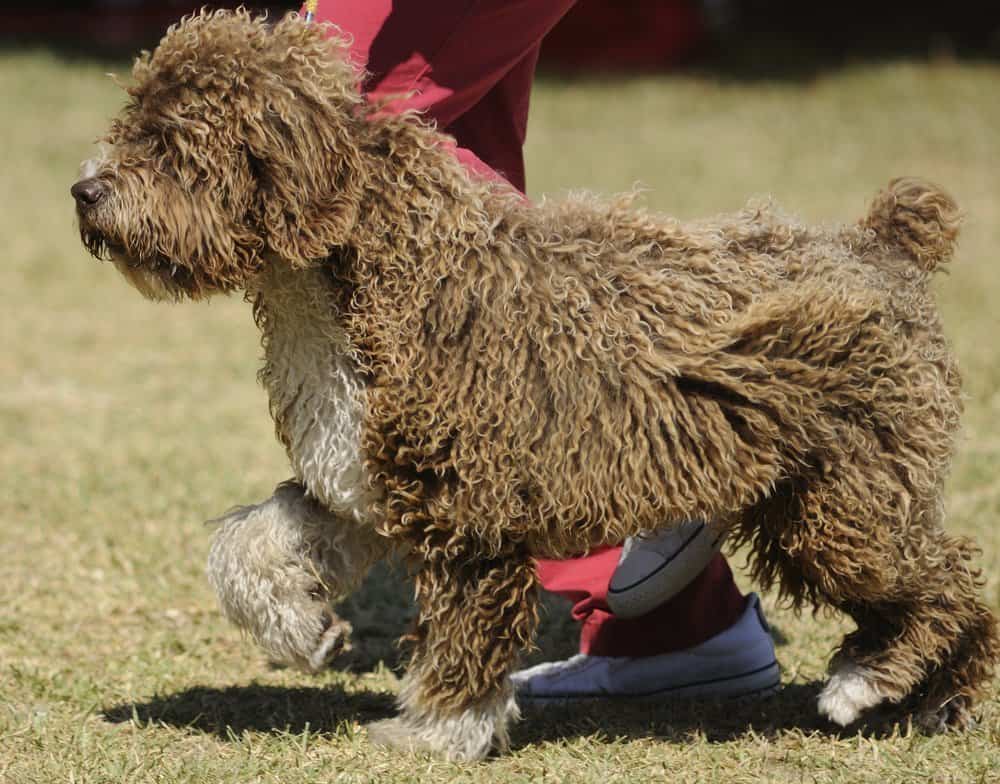
With their usual short-haired grooming, the Spanish Water Dog may not look like a corded breed, but its fur does in fact form dreadlocks when left to its own devices.
This ancient breed was bred to work with livestock and is packed with the necessary energy to run after herds all day long.
These dogs do best in an environment with lots of outdoor access and lots and lots of physical contact.
As a result of its breeding, the Spanish Water Dog has very strong protective instincts. An independent and faithful dog, the Spanish Water Dog will take its job as guard dog very seriously for both livestock and humans alike.
Despite its resemblance to other breeds, the Spanish Water Dog has one of the most distinctive natural looks in all of the canine kingdom.
Its coat grows in a single layer across its entire body, including drooping over the cover of its eyes. The cords formed when left alone are natural and distinctive to the breed.
5. Poodle
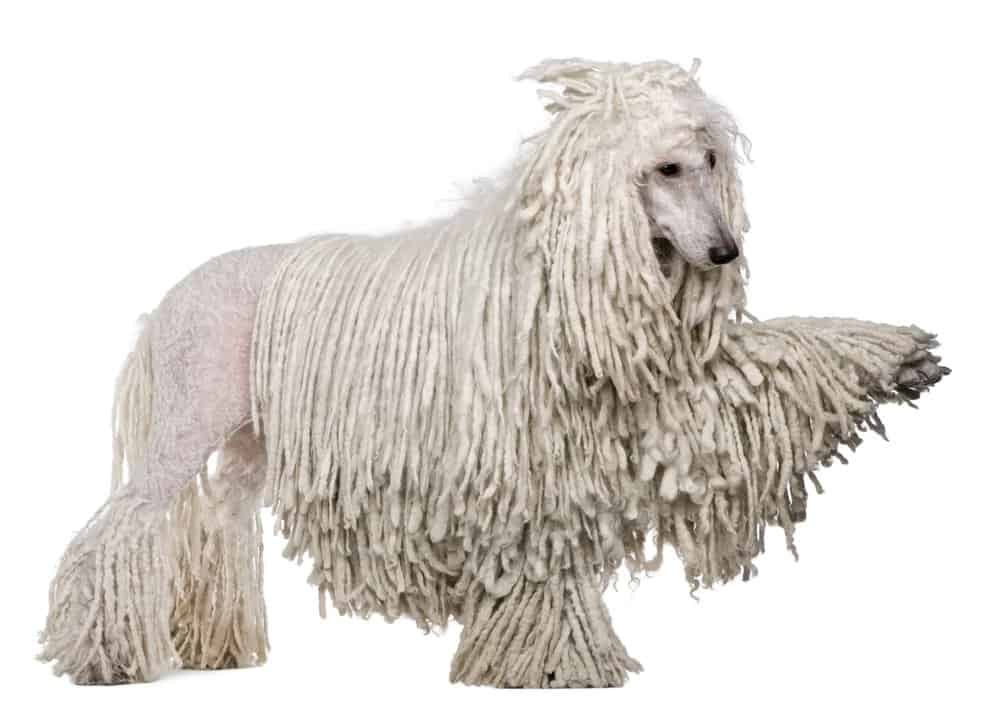
Although the style has lost much of its popularity today, at one time, corded Poodles were as common as their naturally curly-haired counterparts.
A Poodle’s fur may not naturally grow into dreadlocks, but it doesn’t take much cajoling to get it to do so. It does take a fair amount of care to maintain, though, which is one of the main reasons the style has become less popular.
Despite its popular depiction as the French dog, Poodles are actually of German origin. The modern Poodle, as we know, is a shockingly young breed, only established in the 19th century.
They started as hunting dogs, specifically for water hunting, which is the origin of their distinctive, classic haircuts.
Their thick fur was vital for keeping them warm enough but would encumber their movements if left on the entire body, so they were shaved to just protect the necessities: the head, the organs, and the wrists and tail for movement.
Despite their less than glamorous origins, today the image of the Poodle goes hand-in-hand with that of elegance and class.
The corded style, while it takes some effort to maintain, creates a beautiful and unique look that can make a Poodle really stand out against similarly luxurious dog breeds.
6. Bergamasco Sheepdog (Bergamasco Sheperd)
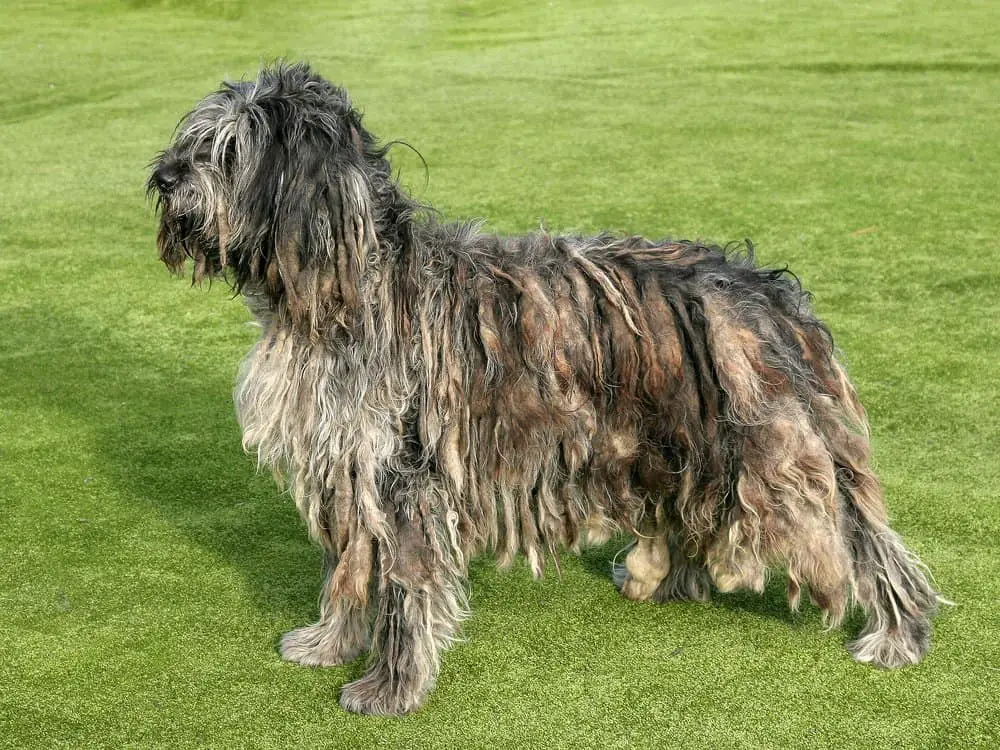
Surprise, surprise—the Bergamasco Sheepdog also has its origins as a herding dog, this time hailing from the mountains of Italy. The oldest breed on this list, the Bergamasco has been helping farmers with their livestock for over 2,000 years.
Those ancient instincts have turned the Bergamasco into one of the best competitive dog breeds, where they thrive, showing off their agility, obedience, and showmanship skills.
A Bergamasco’s corded coat is its most distinguishing factor. Unlike the other corded breed, a Bergamasco’s fur grows in three distinct layers, each one insulating and water-resistant.
Of all the mop dogs, the Bergamasco’s grey to black coloring makes it most look like a dirty mop, but that all helped the breed blend it with its rocky surroundings in the Italian Alps.
Bergamascos are big dogs naturally, and their heavy coats only add to their weight. It’s not surprising to find a mature male of the breed clocking in at over 80 pounds!
It’s not as well-known as the other dogs that look like a mop on this list, but its natural instincts to protect livestock give it an easy-going temperament that makes it a great family dog.
No matter what, though, a Bergamasco Sheepdog should always have free access to the outside. Its thick corded coat makes it durable in the cold mountain weather, but also prone to overheating when forced to stay inside.
Dogs With Dreads
As surprising as they may be to look at when you see a dog with dreadlocks, it’s not cultural appropriation.
These corded dog breeds are growing their fur au naturel!
Mop dogs combine a unique appearance with strong protective instincts—what more could you ask for?
Browse More Weird Dog Breeds below:
References:
1.[^] “Komondor.” Merriam-Webster, Merriam-Webster, https://www.merriam-webster.com/dictionary/komondor.

